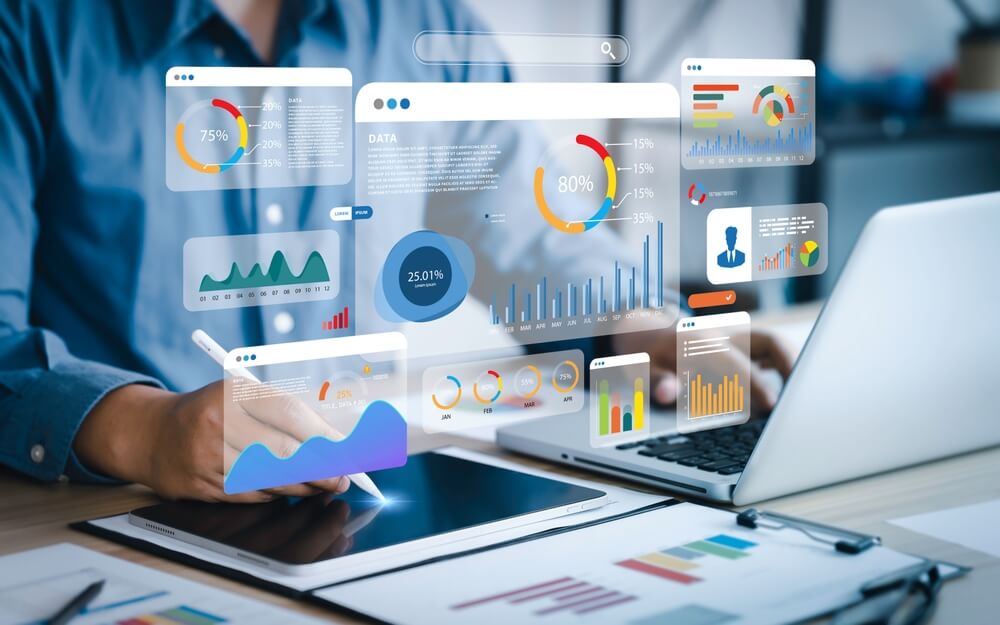
The Next Frontier in Revenue Generation: Predictive Analytics, AI, and Beyond
Traditional sales methods have fallen out of favor. Even digital marketing campaigns are becoming less effective. Competitive businesses use innovative solutions to address this.
One method is to hire a fractional CRO to boost conversions. Some companies also get the help of on-demand sales executives to boost sales. Streamlining operations with fractional sales management is now a trend.
AI, predictive analytics, and other new technologies are shaking things up as well. To help you navigate this next frontier, this article discusses the following points:
- Evolution of revenue generation.
- Role of predictive analytics and AI.
- Future of technology in revenue growth
- Embracing upcoming technology.
Ready to get into the details? Let’s go!
The Evolving Landscape of Revenue Generation

Revenue generation has undergone major changes over the years. Sales techniques have evolved and approaches to business growth have also transformed, thanks to innovative tools and technologies. It can be said with assurance that AI has changed modern marketing, redefining it as a blend of data, insight, and predictive prowess.
Let us take a look at how revenue generation has progressed:
1. Door-to-door sales. The humble beginnings of revenue generation started with face-to-face encounters. Salespeople would physically go to potential customers, promoting products using good old-fashioned charisma.
2. Telemarketing. With the telephone as a tool, sales calls became a more efficient way to reach a wider audience. However, it also meant cold calls and predetermined scripts.
3. Print media and billboards. Advertising shifted to a mass approach, hoping to attract potential customers through newspapers, magazines, and highway billboards.
4. Digital marketing. The rise of the internet came with a new set of opportunities. Email marketing, search engine optimization (SEO), and social media became the new pillars for driving revenue.
5. Ecommerce. A revolution in itself, eCommerce allowed businesses to operate 24/7, reaching global audiences without physical barriers.
6. Artificial intelligence (AI) and predictive analytics. The latest phase, and the focus of this blog, dives deep into how technologies such as AI are setting new paradigms in revenue generation.
Effects of the Digital Age on Sales and Marketing
As technology advances, it fundamentally changes how businesses tackle revenue generation. The digital age has introduced many tools that have revolutionized sales and marketing. Technology is now a cornerstone of contemporary revenue strategies, from data analytics to automated campaigns.
Here are the significant effects of technology on sales and marketing:
- Global reach. Via the internet, a local store now has global visibility, exponentially multiplying its potential customer base.
- Data-driven decisions. Today, businesses have an avalanche of data at their fingertips. This leads to more informed decision-making, making the old "gut feeling" method of choosing strategies nearly obsolete.
- Personalization. Customer segmentation and targeted advertising have reached new heights. It is no longer about creating a one-size-fits-all strategy but tailoring experiences to individual preferences.
- Automated processes. From email marketing campaigns to customer relationship management, many aspects of sales and marketing are automated, saving time and increasing efficiency.
- Immediacy and responsiveness. The digital age has elevated customer expectations. Now, businesses must be available and responsive 24/7, offering instant customer service through chatbots or automated messaging systems.
The common thread that ties these influences together is technology. Advanced algorithms, data analytics, and AI drive these changes.
These are not just optional upgrades. They are necessary shifts for businesses to remain competitive. Attention to emerging technologies such as predictive analytics and AI is crucial for taking your business into the near future.
The Power of Predictive Analytics and AI in Revenue Strategies

Data is the new gold in today’s digitalized business landscape. In this era, understanding the nuances of predictive analytics and AI is becoming non-negotiable for businesses aiming to excel. These advanced tools bring a new level of sophistication to revenue strategies, changing the game for everyone.
Here, we break down the capabilities and benefits of these transformative technologies. We also detail them and see how they harmonize to maximize your revenue potential.
1. Predictive Analytics Defined
Let us discuss what predictive analytics means. At its core, it involves using data, algorithms, and machine learning to forecast future events based on past data. The objective is simple yet powerful: to foresee what is around the corner. This foresight enables businesses to take proactive steps instead of merely reacting to events.
2. Benefits of Predictive Analytics
- Predicting sales trajectories. A key utility of predictive analytics lies in its ability to forecast sales. Analyzing historical and current sales figures lets businesses anticipate future sales patterns. This prediction leads to more efficient resource allocation.
- Optimizing marketing efforts. Predictive analytics serves as a tool for identifying the most impactful marketing activities. This allows businesses to concentrate on tactics that yield the greatest return on investment.
- Understanding customer behavior. This technology allows businesses to delve into customer data. It reveals patterns and trends that can inform more targeted marketing campaigns.
3. Artificial Intelligence Defined
AI refers to computer systems that can perform tasks that typically require human intelligence. These include understanding natural language, solving problems, and making decisions. In revenue generation, AI serves as the brain behind automated systems, capable of making millions of calculations in seconds to optimize results.
4. The Role of AI
a. Automating tasks. One of the major roles of AI is to automate repetitive and time-consuming tasks. This frees up human resources to focus on the business's more creative and strategic aspects.
b. Personalizing customer interactions. Through AI algorithms, businesses are able to offer highly personalized experiences to their customers. Think of recommendation engines on eCommerce websites that suggest products based on your browsing history.
c. Optimizing sales funnels. AI analyzes customer interactions at every stage of the sales funnel to identify areas for improvement, which leads to higher conversion rates.
5. Synergy of Predictive Analytics and AI
Predictive analytics and AI are potent individually, but combined, they become a multiplied force. Here is how they complement each other:
a. More precise targeting. Predictive analytics can identify potential customers or market segments, while AI tailors marketing messages for each segment. This combination leads to more effective and personalized campaigns.
b. Improved efficiency. Both technologies contribute to streamlining operations. Predictive analytics forecast demand, helping with inventory management, while AI automates order processing and customer service. When paired, they make the whole system more efficient.
c. Increased revenue. Ultimately, the duo contributes to increased revenue by enhancing customer experience and optimizing sales and marketing strategies.
6. Real-World Applications Simplified
To better grasp the power of predictive analytics and AI, let us visualize how they can be applied in everyday business scenarios. Here are some clear-cut examples:
- Online clothing shops. Imagine you run an online store that sells clothes. Predictive analytics can look at what customers bought before and guess what they want next season. Then, AI sends out personalized emails recommending these future popular items to customers. This way, you sell more, and customers are happier.
- Software companies. You own a company that sells software subscriptions. Predictive analytics tell you which features of your software keep people coming back. AI helps by answering common customer questions through a chatbot, freeing up your team to work on other tasks.
- Local coffee shops. If you own a small chain of coffee shops and want to open a new one, predictive analytics can look at data such as local demographics to suggest the best location. AI then sets up the employee work schedule, ensuring that you are not understaffed during busy times.
- Digital marketing firms. If you are in digital marketing, predictive analytics scrutinize your previous campaigns to offer insights into future strategies. Meanwhile, AI has the capability to tweak your online advertisements in real time, maximizing your return on investment.
In these examples, predictive analytics help you make smarter plans for the future. AI comes in to make those plans happen right now, automatically. Using both together allows you to be more precise, save time, and make more money.
The Future Potential of Technology in Revenue Growth

The future of predictive analytics and AI is curious. Let us peek over the horizon to explore what is coming up next in the high-tech world of revenue generation. These potential breakthroughs can catapult your business into uncharted territories of success.
1. Virtual Reality (VR) and Augmented Reality (AR)
VR and AR technology are not just for video games or cool Snapchat filters. Businesses are starting to use them in some pretty amazing ways.
- Virtual showrooms. Imagine that you are a car dealer. With VR, customers are able to "walk" through your showroom and "test drive" cars without leaving their homes.
- Augmented shopping. If you run an online furniture store, AR lets customers see how a sofa would look in their living room before they buy it.
VR and AR can mean more engaged customers and, ultimately, more sales.
2. Quantum Computing
Let us proceed into something that sounds like it is straight out of a sci-fi movie: quantum computing. Traditional computers use bits. Quantum computers use quantum bits, or "qubits."
- Speedy calculations. Quantum computers solve complex problems much faster than current computers. This makes your predictive analytics even more accurate.
- Enhanced security. Quantum computing promises better encryption, making online transactions and data storage more secure.
In other words, quantum computing makes everything more efficient and safer, from sales predictions to customer data.
3. New AI Models
Although AI has been discussed, did you know that it is already rapidly evolving? Look at how fast large language models (e.g., ChatGPT, Bard, Bing AI) have developed. New models are coming out to make AI even smarter and more useful.
- Chatbots. Future AI will have chatbots that do not just answer FAQs but can hold a conversation with customers, helping them solve complex problems without human help.
- Predictive behavior. With more advanced AI, you could predict what product a customer might want to buy and suggest products they didn't even know they needed.
As AI improves, it helps your business in ways that you have not thought of yet.
4. Why Businesses Must Stay Updated
You might be wondering why you should care about all this future tech. The business world is like a race and technology is the fast car that helps you win. You might get left behind without paying close attention to the latest tech.
- Competitive advantage. Using the latest tech can give you an edge over your competitors.
- Customer expectations. As people get used to new technology in their daily lives, they expect businesses to use it, too. Do not let your business become outdated.
5. Adapting to the Future
The risks that change brings to businesses can be scary. However, the opportunities it might bring are exciting. The key to making the most of these developing technologies is to be flexible and willing to adapt.
- Training. Keep your team updated with the latest knowledge and skills.
- Budget. Consider setting aside some of your budget for new technology investments.
- Testing. Do not jump in headfirst. Test new technologies on a small scale before fully implementing them.
By being prepared and open to change, you ensure that your business survives and thrives in the future.
The Imperative to Embrace Tomorrow's Tech Today

Business is in constant motion, particularly in the realm of revenue generation. As discussed, frontier technologies such as VR, AR, quantum computing, and emerging AI advancements shape this dynamic landscape.
These are not merely shiny new toys or industry jargon. They have the muscle to transform how businesses operate and flourish. As these technologies continue to evolve, they stand to make every aspect of revenue generation — from efficiency to customer engagement to strategic planning — vastly better.
In a nutshell, whether it be designing immersive experiences to dazzle your customers, executing ultra-fast computations, or employing increasingly intelligent AI solutions, being tech-forward is a necessity. Stay attuned to these technological strides to make sure that your business keeps up and sets the pace.
Summing Up
Business has become more fast-paced than ever. Recognizing the importance of next-gen technologies is essential for ensuring revenue growth. Digital Authority Partners (DAP) can help you succeed and stay ahead of the curve.
Do not miss out on the future — contact us today to elevate your revenue strategies.
Want To Meet Our Expert Team?
Book a meeting directly here




